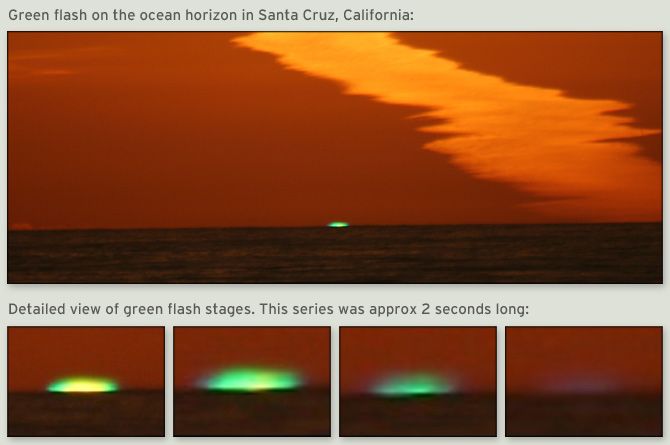A page from the "Causes of Color" exhibit...
Green flashes and ice crystals

The next time you’re lounging on the beach, enjoying the peaceful tranquility and brilliant colors of the sun setting over the ocean, don’t blink. In the right conditions, you may experience a rare treat - a green flash on the rim of the sun.
Very rarely, a green flash can be observed at sunset. It lasts only a few seconds, and can only be seen when the observer can see below the real horizon, for example across water.
Green flashes
The upper limb of the setting sun has a green rim, too thin to be seen by the naked eye. But under particular conditions a mirage is formed, magnifying the green rim so that it is briefly visible. Very few people have seen this effect; it takes either a great deal of luck, or knowledge of exactly where and when the effect is seen.
The green rim itself is caused by refraction. At sunset, the sun’s rays travel their longest path to our eyes through the earth’s atmosphere. Like a prism, the atmosphere separates the sun’s light into its component colors, so that we see overlaid images of the sun’s disc in different colors, the lowest being red and the upper rim, blue to violet.
As the sun sets, sunlight travels through the atmosphere close to the ground, where it is thickest. Red, orange and yellow rays are the least refracted, and these disappear first, though we may see them on the clouds. Violet, blue, and green rays are refracted the most, and are still visible as the sun slips below the horizon. Because violet and blue rays are also scattered more strongly than green rays, it is the green rays that reach us.
Even so, this green rim can only be seen with some magnification, either by projecting an enlarged image onto a screen of some kind, or through the natural effect of a mirage.
Complex refraction effects between the astronomical horizon and the observed horizon may produce mirages, as when the sky is sufficiently clear and the water is cooler than the air above it. Mirages can also be seen on hot asphalt roads, in the desert, or on ice, when layers of air at different temperatures are formed.
As the green rim of the sun crosses through a mirage, it may be magnified for a few seconds, when the images are stretched vertically as they merge. This allows us to view the green flash. There are many types of mirages, and the kind of mirage will determine the type of green flash seen.
As in so many color effects, our perception also plays a role. Looking at the setting sun can create perceptual effects that distort our color perception, so that we misinterpret the color of the flash.
As the light rays close to the horizon experience bending, the refraction allows us to see two or more images of distant objects, erect and inverted, in a mirage. The images are stacked vertically, as though the objects were reflected in water.
Refraction and internal reflection produce a variety of effects around the sun or the moon, at 22° and 45°. This halo at 22° is the result of ice crystals in the atmosphere. Unlike rainbows, these effects are seen in the direction of the sun.
Atmospheric effects caused by ice crystals
Rainbows are caused by refractive dispersion of sunlight by raindrops, which are spherical. When the moisture in the atmosphere is frozen, ice crystals form. These take the shape of hexagonal platelets or pencil-like rods. Because of their shapes, they cause a variety of effects, creating wonderful skyscapes in colder conditions.
The preferred angle of the light for rainbows as seen by an observer is a circle at 42° from the shadow of his head. In contrast, hexagonal ice crystals reflect light to form a circle seen by the observer with an angle of 22° or 45° from the sun itself.






